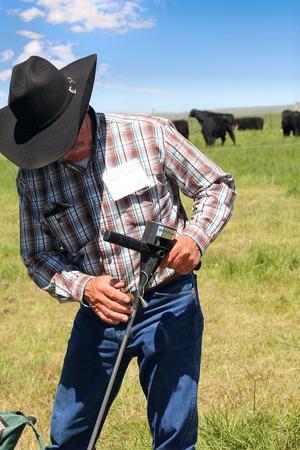
Montana Welcomes Back the Prairie Grass
A new grazing program will help improve soil health and forage for cattle and sequester carbon to mitigate the effects of climate change
BIG TIMBER, MONTANA - July 17, 2019 (Investorideas.com Newswire) Dylan Hoffman, Director of Sustainability forXanterra Travel Collection , which managesYellowstone National Park Lodges , left a board meeting of Western Sustainability Exchange earlier this year and paused to take in the panoramic view of Roger Indreland's cattle ranch north of Big Timber, Montana.

Photo Caption: Roger Indreland of Indreland Angus demonstrates the use of a penetrometer to measure the compaction of the soil which can be an indication of soil quality. Indreland is one of the four ranchers enrolled in the initial phase of the Montana Improved Grasslands Project. Credit: Jon Sepp
"It is absolutely an idyllic landscape," he says, "It doesn't look like a working cattle ranch. It looks like native grassland landscape."
Hoffman's view in many ways was a glimpse back into centuries past when bison roamed Montana grasslands, and the ecosystem was in balance, flourishing.
Indreland is one of four ranchers participating in a 35,000-acre project to improve soil health and forage for cattle, and sequester carbon in the soil to help mitigate the effects of climate change. Hoffman got interested in the idea through his work with Western Sustainability Exchange, a non-profit dedicated to preserving the best of the West - farming and ranching heritage, wide open spaces, and wildlife habitat - all while strengthening rural economies. The project was launched this year by WSE, Xanterra, and NativeEnergy, a pioneering carbon offset provider.
Pull-quote: "As part of what's called the Montana Improved Grazing Project, the ranchers agree to implement sustainable management practices, notably high intensity, rapid rotational grazing."
As part of what's called the Montana Improved Grazing Project, ranchers agree to implement science-based sustainable management practices, notably high intensity, rapid rotational grazing. That means cattle graze in temporary pastures as small as 25 acres for short periods, then those grasses are left undisturbed for a year or longer. The effect, Hoffman notes, is to mimic how migrating bison foraged on the grasslands for 100,000 years.
"They are hitting it hard and grazing it the way those grasses have evolved to be grazed and then letting it sit, just like it would when there were herds of wild bison roaming the West," he adds.
The program is the first of its kind in the US, and has huge potential. 41% of land in the lower 48 states is used for livestock pasture and feed. Globally, livestock and related land-use changes account for 14.5% of greenhouse gas emissions. Recent research indicates that grasslands may be even more effective than forests at sequestering carbon, a driver of climate change and its disruptive consequences. Further, the program helps restore a damaged ecosystem. In the past 200 years, some cattle ranching has caused over-grazing, resulting in increased bare ground, erosion, loss of perennial grasses, reduced capacity to hold water and, ultimately, lower productivity for ranchers.
Through NativeEnergy's program, called Help Build, ranchers receive training and funding for improvements such as fencing and water infrastructure so they can increase the number of pastures, decrease their size, and increase the speed of cattle rotations. That means more grassland is rested, giving it a chance to recover. Without the influx of cash at the project's start, ranchers are unlikely to make the investment to change their practices, according to Jeff Bernicke, Native Energy's President. "There needs to be financing for ranchers," he says.
About five years after the program begins, NativeEnergy will have an independent third party measure the carbon sequestered in the soil. Ranchers are paid based on the amount of sequestered carbon credits their land yields. A key component is that ranchers commit to the program for 30 years, Bernicke says. Changing practices for just a year here or a year there doesn't have a lasting environmental impact. Committing to them for three decades does. "We need to make sure they have skin in the game," he adds.
The advantages to ranchers go beyond another source of income. They benefit from the increased productivity of the land. More forage means ranchers don't have to buy as much hay. Healthier grasslands mean they can increase the density of their stock. In addition, they can sell their beef as sustainably raised. And, over time, the value of their land increases.
Restoring grasslands bordering the park has advantages beyond the ranches. The elk, mule deer, pronghorn, bighorn sheep, wolves, trout, and other species throughout the Greater Yellowstone Ecosystem will benefit from improved habitat. So will the local communities that depend on ranching, tourism, and outdoor recreation.
"This Help Build model is that much more powerful because what we're doing is creating something that has a tangible impact not just globally or nationally, but here locally," Hoffman says.
For Xanterra, the program helps shrink its carbon footprint and supports ranchers who are Yellowstone's neighbors. The company's key sustainability goals include reducing its carbon dioxide (CO2) emissions by 50 percent by 2025 compared to a 2014 baseline. While Xanterra has added solar arrays, recycling and composting programs, and energy and water efficiency projects, increased visitation at its properties means emissions are rising. Purchasing carbon offsets from companies like NativeEnergy provides a solution and this program is allowing Xanterra to offset the carbon emissions for 100% of its fossil fuel based electricity in Yellowstone.
Xanterra is already committed to providing guests with more environmentally friendly food options - buying 60 percent either locally or through certified sustainable suppliers. The NativeEnergy program allows the company to go a step further by connecting the dots between sustainable food, local ranching, and mitigating the impacts of climate change "It is a perfect program for us," Hoffman says. "It really checks all the boxes."
"It's amazing to see the work you're doing have an impact on preserving this landscape, preserving a lifestyle, and ultimately creating quality, sustainable beef products that we can serve to our visitors," he adds. "It was very powerful to see it in person. You can see the tangible difference you're making in the world."
Interviews and visuals available upon request.
Media Contact Only:
Katie Dabbs, Percepture,
René A. Mack, Percepture,
More Info:

This news is published on the Investorideas.com Newswire - a global digital news source for investors and business leaders
Disclaimer/Disclosure: Investorideas.com is a digital publisher of third party sourced news, articles and equity research as well as creates original content, including video, interviews and articles. Original content created by investorideas is protected by copyright laws other than syndication rights. Our site does not make recommendations for purchases or sale of stocks, services or products. Nothing on our sites should be construed as an offer or solicitation to buy or sell products or securities. All investment involves risk and possible loss of investment. This site is currently compensated for news publication and distribution, social media and marketing, content creation and more. Contact each company directly regarding content and press release questions. Disclosure is posted for each compensated news release, content published /created if required but otherwise the news was not compensated for and was published for the sole interest of our readers and followers. More disclaimer info:https://www.investorideas.com/About/Disclaimer.aspLearn more about publishing your news release on the Investorideas.com newswirehttps://www.investorideas.com/News-Upload/
Additional info regarding BC Residents and global Investors: Effective September 15 2008 - all BC investors should review all OTC and Pink sheet listed companies for adherence in new disclosure filings and filing appropriate documents with Sedar. Read for more info:https://www.bcsc.bc.ca/release.aspx?id=6894 . Global investors must adhere to regulations of each country.
Please read Investorideas.com privacy policy:https://www.investorideas.com/About/Private_Policy.asp


Get moreRenewable Energy stock investor ideas- news, articles, podcasts and stock directories

Legal Disclaimer:
MENAFN provides the
information “as is” without warranty of any kind. We do not accept
any responsibility or liability for the accuracy, content, images,
videos, licenses, completeness, legality, or reliability of the information
contained in this article. If you have any complaints or copyright
issues related to this article, kindly contact the provider above.

















Comments
No comment